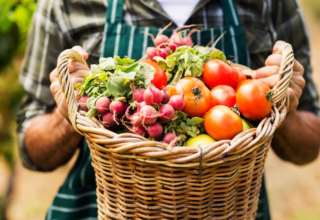Although simple in theory, this traditional noodle-based soup packs a flavourful punch and has surpassed the street food stalls of Vietnam
Pho, pronounced ‘fuh’, is considered to be a national dish for the Vietnamese and is believed to date back to the late 19th century or the early 20th century in northern Vietnam. Traditionally made with chicken or beef broth, and spiced with an array of flavours and topped with herbs, Pho has gone on to capture the attention of the Western world given its complex characteristics. This dish’s origins are poorly documented, resulting in significant disagreement over the cultural influences that led to its development in Vietnam and the etymology of the word. However, it remains very much undisputed that this soup is remarkably delicious and well worth a mention and a try.
Basic types of pho
There are many variations, although beef (Pho bo) and chicken (Pho ga) remain the most popular options.
Pho bo: Normally, the beef used in pho bo is medium-rare, and continues to cook in the steaming soup broth. Beef options can include flank steak, crunchy flank steak, tendons, beef meatballs and fatty brisket.
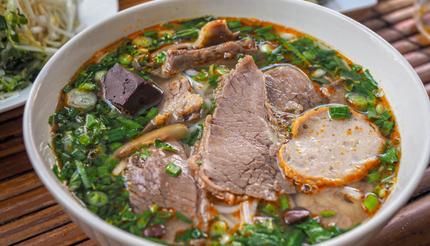
Pho ga: This chicken soup is more straightforward, with chicken added to the broth, and mixed with vegetables, basil, bean sprouts, chilli, scallions and coriander. Popular condiments for both soups are chilli sauce, lime and hoisin sauce – a sweet and spicy sauce made from soya beans, sugar, garlic and vinegar.
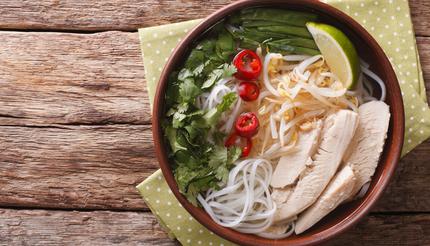
A broth health boost
Pho is not just hearty, comforting and notably tasty – it also has an array of health benefits. If you hold back on the noodles and sodium and go heavy on the vegetables, you have the ultimate nutritious, filling and low-calorie meal or snack. This is another reason why pho has become so popular and made its way into mainstream cuisine.
One bowl of pho is thought to contain around 30 grams of protein – which is about half the recommended amount per day for most people. The dish has also been compared to chicken soup, and will do the trick when you are coming down with a cold. You can even do what the Vietnamese do and have a bowl of pho for breakfast, starting your day on a highly nutritious note.
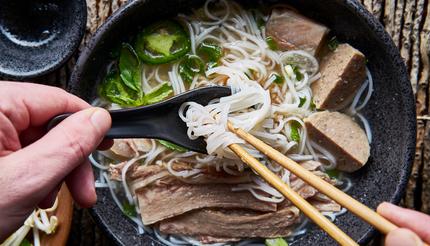
A popular pho theory
One of the most popular theories is that pho came about during the French colonisation of Vietnam and that the source of the term ‘pho’ derives from ‘feu’ – the French word for fire. The Vietnamese then went on to adapt the dish further, drawing inspiration from the French signature beef stew, called pot au feu. Before the French had arrived in Vietnam, the locals didn’t slaughter cows for food, but after the French had taken over, the Vietnamese changed their practices and started killing cows to obtain the marrow-rich, cartilaginous bones that create the broth.
After Vietnam was divided in 1954, the popularity of pho spread from the north to the south of Vietnam, but the styles diverged. The northern version of pho (phở bắc) is simple, with fewer ingredients and cuts of meat, although the flavours are intense, and ingredients such as cloves, cinnamon and anise add to the taste. The southern version of pho (phở nam) is more complex and features plenty of ingredients, herbs and garnishes. It is also served in a bigger bowl, loaded with garnish, and heavily seasoned using hoisin sauce.
Pho was thought to have been in particular demand with the workers from the provinces of Yunnan and Guangdong, as they found it to be similar to dishes of their homeland. Originally, pho was sold at dawn and dusk by street vendors who would carry their mobile kitchens on poles over their shoulders. Attached to the poles would be two wooden cabinets, one that contained a cauldron over a wood fire, and the other that stored noodles, spices and cooking equipment along with space to prepare a bowl of pho. These vendors wore distinctive felt hats (mũ phở) to keep their heads warm while selling bowls of pho to the locals.
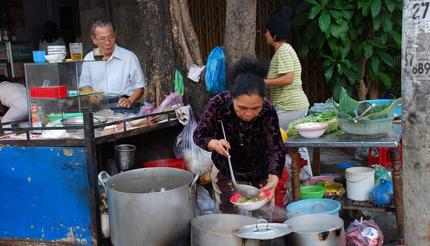
Worldwide love for pho
Wherever Vietnamese communities have built up, the concept of pho has followed, and it’s bound to feature on the menu of every traditional Vietnamese restaurant. When Vietnamese refugees began immigrating to the US in the 1970s, pho became extremely popular in America, particularly the southern-style. The dish’s French influence also means that you can find it in Vietnamese restaurants in Paris, and in the main cities across Europe, where pho remains the star of the show.
What else to know about pho
The term pho actually refers to the noodles, not the soup itself, and although there are several soup dishes in Vietnamese cuisine, pho is the only one that uses pristine white flour noodles. A pho’s quality is judged by the broth, and a good bowl of pho is crystal clear, with plenty of flavour. Often when you are served pho, you will be given garnishes on the side – these should be ripped up and sprinkled in the soup as opposed to submerging the entire leaves. When it comes to condiments, less is more – if a broth is good, it should be savoured and not compromised. You can also forget your table manners, as it is common to sip the broth of the pho and eat the noodles separately.
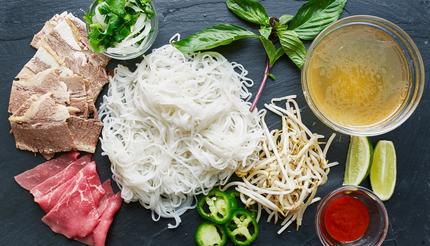
This article was first published in 2016 and has been updated on 01/08/19.
If you liked this article, you might also like:


